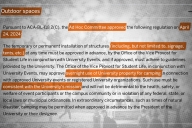You have /5 articles left.
Sign up for a free account or log in.
WASHINGTON -- They're sometimes controversial among faculty, but -- love them or hate them -- theme-based general education "pathways" programs, in which required coursework is grouped into academically or socially relevant themes for a more meaningful undergraduate experience, are a growing trend. Or so it appeared Friday at a standing-room-only session on pathways at the American Association of Colleges and Universities’ annual conference here. Asked by panelists who had introduced theme-based general education requirements at their institutions, about a dozen attendees -- mostly administrators -- raised their hands. Asked again how many attendees were considering such programs, nearly all answered in the affirmative.
Panelist William Loker, dean of undergraduate education at California State University at Chico, didn’t pull any punches in describing the challenges of initiating a theme-based general education program at his institution. Through a humorous graphic, he said its 18-month old General Education Pathway Program saw many phases before it launched, including: enthusiasm, disillusionment, chaos, and “punishment of the innocents.”
Part of the difficultly for Chico was designing and rolling out Pathways in three years, in order to be part of AAC&U’s Give Students a Compass initiative to make general education more engaging and relevant, among other goals. Chico was already planning on a curricular redesign, but used the funds associated with the AAC&U program to “jump start” the overhaul, Loker said. Three years isn’t exactly a short timeline as far as curricular redesigns go, but hard deadlines pose challenges for any institution – and Chico State is a large university that’s part of the nation’s largest public education system.
Loker said Chico State had several goals for its program. It had to be: compatible with California State System general education (a relatively standard set of required courses in various disciplines and additional, cross-curricular work, plus nine upper-level credits, making for 48 credits total, or 40 percent of the undergraduate degree); affordable; assessable; and, most importantly, “coherent” – not just a series of courses.
Debra David, project director for Give Students a Compass at the California State University System, said the program also had to work within two years, given the number of transfer students from two-year institutions in that state, in addition to those who “swirl” in and out of college before graduating, if at all.
In a standard general education program, students typically take a handful of core required courses in various disciplines, supplemented by additional credit hours in those disciplines (but students choose the courses). In a thematic pathways framework, students are required to take courses that develop various competencies, such as critical thinking or writing, across the curriculum. But they’re also encouraged or required to complete them in thematic course groupings, or pathways. The idea is that pathways create a more meaningful experience for students, resulting in more lasting learning.
At Chico, faculty, students and administrators met and provided input on the Pathways project and what its themes should be. In the end, they settled on 10 pathways, including: diversity studies; gender and sexuality studies; great books and ideas (which Loker said was a faculty favorite, if not a student one); science, technology and values; and food studies.
Loker said the collaborative design process ensured a certain amount of faculty buy-in. Students also appreciate that the nine-credit requirement in an upper-level pathway leads to a minor in that pathway – what Loker called “value added.” The bigger challenge is maintaining that sense of buy-in, along with faculty identification with the program, he said, as the program goes on. With just three semesters down, and a whole scale assessment planned for 2017, it’s hard to know yet if Pathways is doing what it set out to do – make general education better.
David said thematic pathways make “a lot of sense,” but administrators and faculty members now need to be thinking, “What data do we need to collect? What questions do we need to ask?”
Despite the lack of data, Loker said Chico feels it finally has a program that’s “amenable” to assessment, and that that’s already and improvement. And it’s not the administrators who will be doing all the assessing; faculty members who have volunteered to serve as heads of each pathway will be compensated, through a reduced teaching load, to assess the “programmatic” value of the pathway. Loker said that’s different from individual course assessment, which he called “curricular policing.”
“We wanted to move away from that,” he said.
He called collecting enough data through assessment to eventually improve on the Pathways program the “gold standard.”
The session also feature speakers from the Metro Academies initiative between City College of San Francisco and San Francisco State University. In that program, designed mainly for first-generation students, cohorts at both institutions take two general education courses paired with themed courses on health, early childhood, or other issues, depending on their academy, for four semesters. Program leaders said participants have higher retention rates than their peers outside the program.
Pathways are on the rise as institutions see increasing pressure to demonstrate the value of a degree, and, at some colleges, they're seen as a way of branding the curriculum for better recruiting and retention.
"We can't survive the way [our general education program] is now," said Shirley Williams-Kirksey, dean of the School of Arts and Sciences at Clark Atlanta University, who attended the session. Clark Atlanta, a predominantly black, liberal arts-focused institution, has been in talks about reforming its general education requirements for three years. But faculty and administrators have yet to settle on a concept. Theme-based pathways are appealing because they can enhance student interest, she said.
"Students always ask, 'Why do I have to take this course?'" Williams-Kirksey said of the university's current core requirements. "With this new, thematic approach, they have options." Additionally, she said, the interconnectedness of the curriculum in a thematic schema makes it so that each course "is a thread they're weaving into a cloth of many colors, or a quilt."









